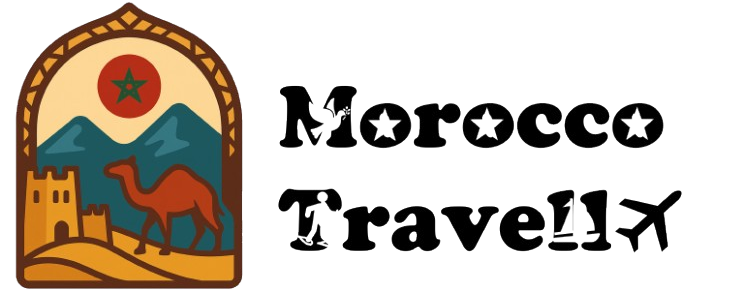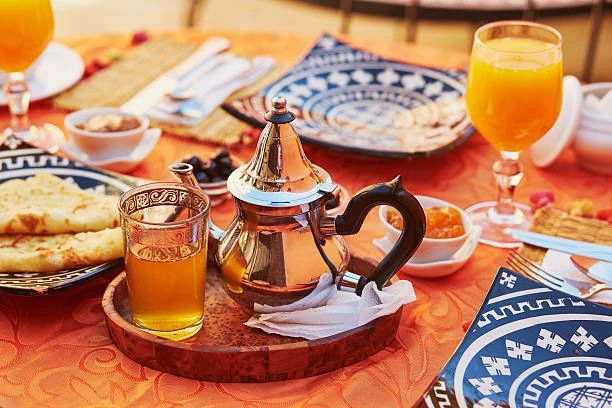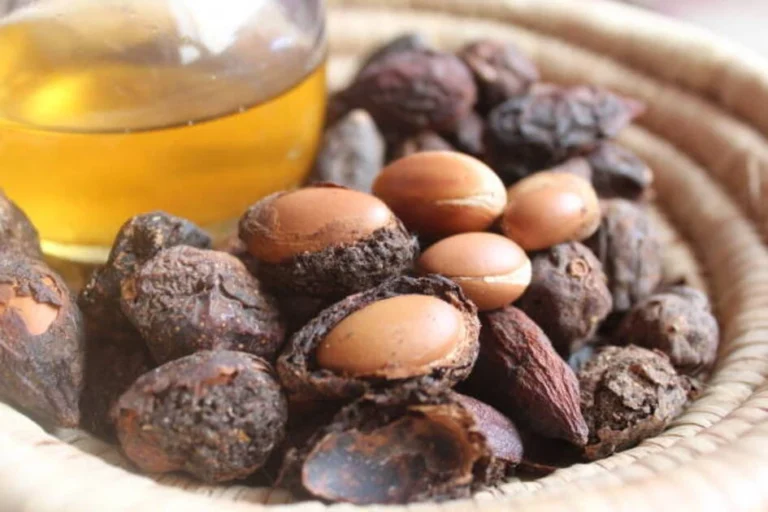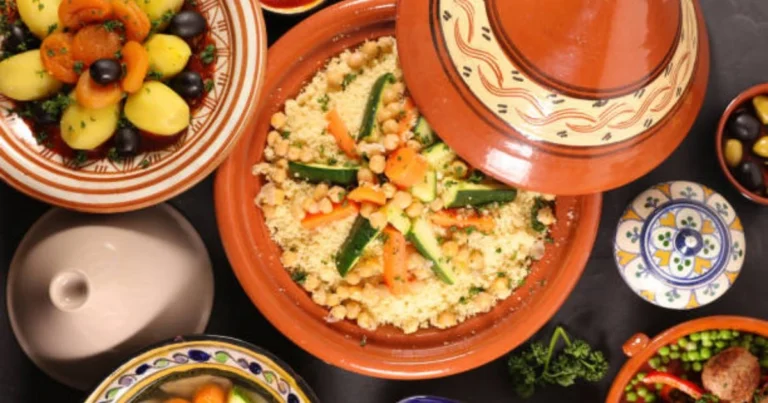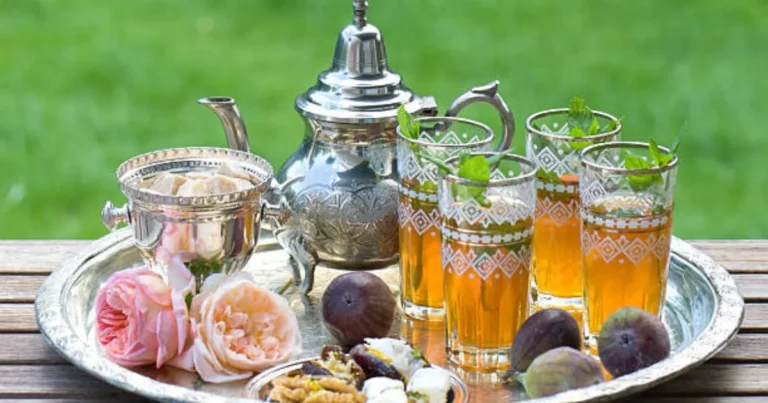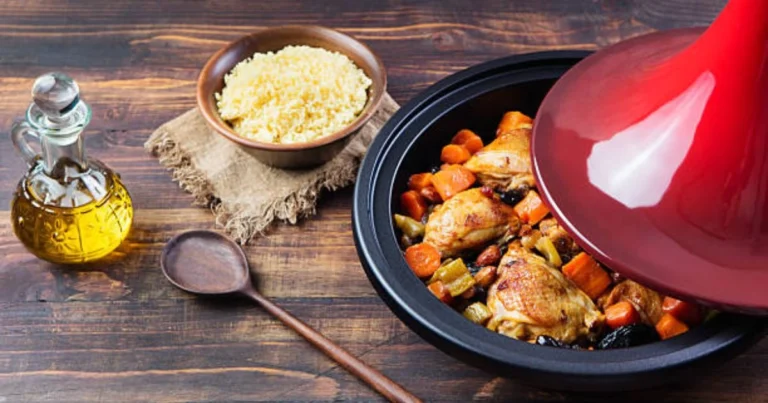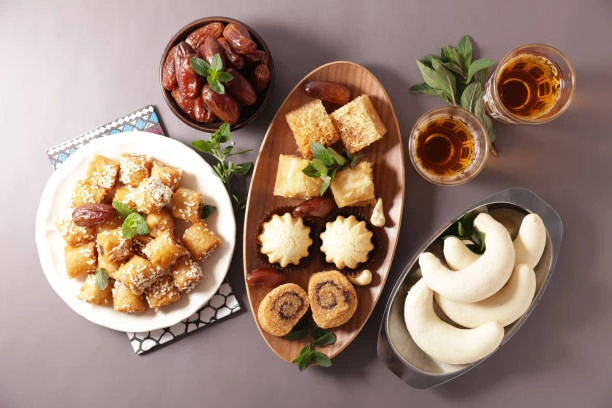Top Moroccan Breakfast Food to Start Your Day
Imagine starting your day with a warm, inviting cup of mint tea and a variety of delicious accompaniments. In Morocco, breakfast is a cherished tradition that brings people together. Moroccan cuisine offers a rich heritage, and its breakfast dishes are no exception.
You might be surprised to learn that the traditional Moroccan breakfast often includes a mix of sweet and savory flavors. From honey and jam to olive oil and cheese, the options are diverse and tantalizing. As you explore the world of Moroccan breakfast, you’ll discover a culinary experience that’s both nourishing and delightful.
Let’s dive into the fascinating world of Moroccan breakfast food and uncover its secrets. With its unique blend of flavors and cultural significance, you’ll want to start your day with a taste of Morocco.
Table of Contents
The Rich Heritage of Moroccan Breakfast Culture
In Morocco, breakfast is more than just a meal; it’s a significant part of the daily cultural fabric. You are invited to explore the rich heritage of Moroccan breakfast culture, where traditional flavors and regional specialties come together to start the day.
The Importance of Breakfast in Moroccan Daily Life
Breakfast holds a special place in Moroccan daily life, often being a time for family gatherings and social bonding. Msemen, a square-shaped pancake, is a popular breakfast dish in many parts of Morocco, often served with tea or coffee. The importance of breakfast in Moroccan culture is also reflected in the variety of breads and pastries that are freshly baked every morning.
You can experience the warmth of Moroccan hospitality through its breakfast traditions, which emphasize sharing meals with family and friends.
Regional Variations in Moroccan Morning Meals
Morocco’s diverse regions each have their unique breakfast traditions. In the north, you might find msemen and other savory dishes, while in the south, breakfast might include sweet pastries and local specialties. The regional variations are a testament to Morocco’s rich cultural diversity and the adaptability of its cuisine.
As you explore Moroccan breakfast culture, you’ll discover that each region offers a distinct flavor profile, making the morning meal a fascinating culinary journey.
Essential Ingredients for Authentic Moroccan Breakfast Food
To create an authentic Moroccan breakfast, you’ll need to familiarize yourself with the essential ingredients that make these dishes so special. Moroccan breakfast cuisine is rich in flavors and aromas, thanks to the use of high-quality ingredients.
Staple Grains and Flours
Moroccan breakfasts often feature staple grains like semolina, which is used to make couscous, a popular breakfast dish. Other grains and flours used include wheat flour for making traditional bread like Khobz. These grains provide the foundation for many Moroccan breakfast staples.
Key Spices and Aromatics
Spices play a crucial role in Moroccan cuisine, including breakfast dishes. Common spices used include cumin, coriander, and ginger, which add depth and warmth to various breakfast foods. Aromatics like garlic and onions are also frequently used.
Fresh Produce and Accompaniments
Fresh produce is also a key component of Moroccan breakfasts. Ingredients like olives, citrus fruits, and fresh herbs are commonly used. These ingredients are often served as accompaniments to bread and other staple dishes, adding freshness and flavor to the meal.
By incorporating these essential ingredients, you can create a delicious and authentic Moroccan breakfast experience in your own home.
How to Make Msemen: The Beloved Moroccan Square Pancake
Making msemen, a beloved Moroccan breakfast food, is simpler than you think, and it’s a great way to explore Moroccan cuisine. Msemen is a thin layer of dough that is folded and cooked on a griddle, often filled with a variety of ingredients such as onions, meat, and spices.
Traditional Msemen Recipe Step-by-Step
To make msemen, you will need to start by preparing the dough. Mix together flour, water, and salt to form a smooth dough. Let it rest before dividing it into small balls. Roll out each ball into a thin layer, brush with oil, and fold it into a square shape. Cook on a hot griddle until golden brown.
- Prepare the dough by mixing flour, water, and salt.
- Let the dough rest for at least 30 minutes.
- Divide the dough into small balls and roll out each into a thin layer.
- Brush the dough with oil and fold into a square shape.
- Cook on a hot griddle until golden brown on both sides.
Common Variations and Fillings
Msemen can be made more interesting with various fillings. Some popular options include:
- Onions and spices for a savory flavor
- Minced meat for added protein
- Herbs like parsley or cilantro for freshness
| Filling | Description | Taste |
|---|---|---|
| Onions & Spices | Sautéed onions with a mix of spices | Savory |
| Minced Meat | Cooked minced meat with herbs | Hearty |
| Herbs | Fresh or dried herbs like parsley | Fresh |
Experimenting with different fillings can help you find your favorite way to enjoy msemen.
Preparing Baghrir: Moroccan Honeycomb Pancakes
Discover the art of making Baghrir, the beloved Moroccan honeycomb pancakes that will elevate your breakfast game. Baghrir is a traditional Moroccan breakfast dish that is cooked on one side and has a characteristic honeycomb texture, making it perfect for soaking up honey and butter.
Step-by-Step Guide to Perfect Honeycomb Texture
To achieve the perfect honeycomb texture, follow these steps:
- In a large mixing bowl, combine 1 cup of semolina flour, 1 cup of all-purpose flour, and 1/2 teaspoon of salt.
- In a separate bowl, dissolve 1 teaspoon of active dry yeast in 1 cup of warm water. Let it sit for 5-10 minutes until frothy.
- Add the yeast mixture to the dry ingredients and mix well.
- Gradually add 1 cup of lukewarm water while continuously mixing until the batter is smooth and free of lumps.
- Let the batter rest for 30-45 minutes until it becomes bubbly and frothy.
- Heat a non-stick pan or griddle over medium heat. Pour a ladleful of batter onto the pan and tilt to spread evenly.
- Cook until the surface is covered with bubbles and the edges start to dry. Do not flip.
| Ingredient | Quantity | Purpose |
|---|---|---|
| Semolina Flour | 1 cup | Provides texture and structure |
| All-purpose Flour | 1 cup | Adds lightness and tenderness |
| Active Dry Yeast | 1 teaspoon | Ferments the batter for honeycomb texture |
Serving Suggestions and Toppings
Baghrir is traditionally served with a drizzle of honey and a pat of butter. You can also experiment with other toppings such as:
- Fresh fruit like strawberries or bananas
- Nutella or other chocolate spreads
- Powdered sugar for a sweet finish
Troubleshooting Common Baghrir Problems
If your Baghrir doesn’t turn out as expected, check the following:
- If the pancakes are too dense, ensure the yeast is active and the batter rested long enough.
- If the honeycomb texture is missing, check that the batter was not overmixed and that the pan was at the right temperature.
Baking Khobz: Traditional Moroccan Breakfast Bread
Baking khobz is a simple yet rewarding process that brings a taste of Morocco to your breakfast table. This traditional bread is a staple in Moroccan households, often served during breakfast with various accompaniments.
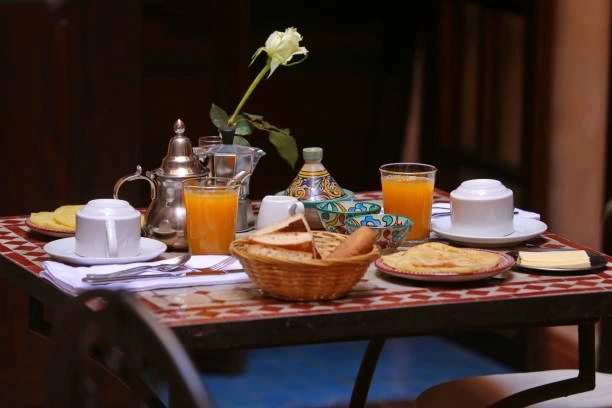
Basic Khobz Recipe and Technique
To make khobz, you’ll need semolina flour, yeast, water, and salt. Start by mixing the dry ingredients, then gradually add water to form a dough. Let it rise before shaping it into rounds and baking in a hot oven.
Key steps include:
- Mixing semolina flour, yeast, and salt.
- Gradually adding water to form a dough.
- Letting the dough rise.
- Shaping into rounds.
- Baking in a preheated oven.
Regional Variations of Morning Bread
While the basic ingredients remain the same, regional variations of khobz exist. Some areas may use a blend of semolina and all-purpose flour, while others might add ingredients like olive oil or herbs for extra flavor.
You can experiment with different variations to find your preferred taste. Whether you stick to the traditional recipe or innovate with new ingredients, khobz is sure to become a breakfast favorite.
Popular Moroccan Breakfast Food You Should Try
When it comes to Moroccan breakfast food, you’ll discover a world of savory and sweet delights that are sure to tantalize your taste buds. Moroccan cuisine offers a diverse range of breakfast options, from traditional bread and pancakes to sweet pastries and spreads.
Savory Morning Staples
Moroccan breakfasts often feature savory dishes that are both nourishing and flavorful. Msemen, a square-shaped pancake, is a beloved breakfast staple, typically served with a variety of fillings such as onions, meat, and spices. Another popular option is Khobz, a traditional Moroccan bread that’s often enjoyed with olive oil, butter, or jam.
Sweet Breakfast Favorites
Moroccans also have a sweet tooth when it comes to breakfast, with a range of delicious pastries and desserts to choose from. Baghrir, or Moroccan honeycomb pancakes, are a sweet breakfast treat, typically drizzled with honey and butter. Other sweet breakfast favorites include ghriba, a shortbread-like cookie, and m’hancha, a pastry made with layers of flaky dough and honey.
Creating Delicious Moroccan Breakfast Spreads and Dips
The art of creating Moroccan breakfast spreads is a culinary journey worth exploring. Moroccan cuisine is renowned for its rich flavors and aromas, and breakfast is no exception. Spreads and dips play a crucial role in enhancing the breakfast experience, offering a delicious start to the day.
How to Make Amlou: Argan Oil Almond Spread
Amlou, a traditional Moroccan spread, is made from argan oil, almonds, and honey. To make amlou, you’ll need to blend roasted almonds with argan oil and a touch of honey until you achieve a smooth consistency. This spread is not only delicious on bread but also serves as a nutritious dip for fruits or vegetables. Key ingredients include high-quality argan oil and fresh almonds.
- 1 cup roasted almonds
- 1/2 cup argan oil
- 2 tbsp honey
Fresh Cheese and Dairy Options
Moroccan breakfasts often feature fresh cheese and dairy products. You can create a simple yet delicious spread by mixing soft cheese with herbs like parsley or mint. Another option is to serve yogurt with honey and nuts for added flavor and texture. These dairy-based spreads offer a refreshing contrast to the richer, oil-based spreads.
Olive and Vegetable-Based Spreads
Olive tapenade and other vegetable-based spreads are also popular in Moroccan cuisine. To make a simple olive tapenade, blend pitted green or black olives with garlic, lemon juice, and olive oil. You can also add roasted vegetables like eggplant or red peppers to create a flavorful spread. These options are perfect for those looking for a dairy-free or vegan alternative.
Mastering Moroccan Egg Dishes for a Hearty Start
Egg dishes in Moroccan cuisine are not just a meal, they’re an experience that combines rich flavors and traditions. You can elevate your breakfast game by incorporating these delicious and hearty dishes into your morning routine.
Shakshuka: Step-by-Step Recipe
Shakshuka is a popular North African dish that has become a staple in Moroccan cuisine. It’s made by poaching eggs in a spicy tomato sauce. To make shakshuka, you’ll need:
- 2 large onions, chopped
- 2 large bell peppers, chopped
- 3 garlic cloves, minced
- 1 can of diced tomatoes
- 1 teaspoon of smoked paprika
- Salt and pepper to taste
- 2 tablespoons of olive oil
- 2 eggs
- Fresh parsley, chopped (optional)
Start by heating the olive oil in a large cast-iron skillet. Add the onions and bell peppers, cooking until they’re softened. Add the garlic, smoked paprika, salt, and pepper, and cook for another minute. Then, add the diced tomatoes and simmer the sauce until it’s thickened. Create wells in the sauce and crack the eggs into them. Cover the skillet and cook until the eggs are set. Garnish with chopped parsley if desired.
Khlea with Eggs: Traditional Preparation Method
Khlea is a traditional Moroccan preserved meat, often made from lamb or beef. It’s typically served with eggs for a hearty breakfast. To prepare khlea with eggs, you’ll need:
- 1 tablespoon of khlea, crumbled
- 2 eggs
- 1 tablespoon of olive oil
- Salt and pepper to taste
- Fresh parsley, chopped (optional)
Heat the olive oil in a small skillet over medium heat. Add the crumbled khlea and cook until it’s lightly browned. Crack the eggs into the skillet and scramble them with the khlea. Season with salt and pepper to taste. Serve hot, garnished with chopped parsley if desired.
By mastering these Moroccan egg dishes, you can add a delicious and authentic touch to your breakfast routine. Whether you prefer the spicy kick of shakshuka or the savory flavor of khlea with eggs, these dishes are sure to become new favorites.
Brewing the Perfect Beverages for Your Moroccan Breakfast
To complete your Moroccan breakfast experience, you’ll need to brew the perfect beverages. Moroccan breakfasts are known for their rich flavors and aromas, and the right drinks can elevate this experience. In this section, we’ll explore the traditional Moroccan beverages that are a must-have during breakfast.
Mint Tea Preparation Guide
Moroccan mint tea is a staple at any Moroccan breakfast. To prepare it, you’ll need green tea leaves, fresh mint, and sugar. Start by boiling water and adding green tea leaves. Let it steep for a few minutes before adding fresh mint leaves and sugar to taste. The key to a perfect Moroccan mint tea is the balance between the tea’s bitterness and the sweetness of the sugar, along with the freshness of the mint.
Coffee Traditions and Preparation Methods
Coffee is also a beloved beverage in Morocco, with a rich tradition of preparation methods. Moroccan coffee is typically strong and served in small cups. To make traditional Moroccan coffee, use finely ground coffee beans and brew them in a small pot called a ‘briki’ or ‘ibrik’. The coffee is then served in small cups, often with sugar but never milk. The art of making Moroccan coffee lies in its strong flavor and the ritual of serving it to guests.
Conclusion: Creating Your Own Authentic Moroccan Breakfast Experience
You now have a deeper understanding of the rich and diverse world of Moroccan breakfast cuisine. With its variety of dishes and beverages, you can create your own authentic Moroccan breakfast experience at home.
To get started, experiment with new ingredients and techniques, such as making Msemen or Baghrir, or brewing traditional Moroccan mint tea. Incorporate these dishes into your daily routine to add some excitement to your morning meals.
By embracing the flavors and traditions of Moroccan breakfast culture, you can create a unique and delicious breakfast experience that will leave you feeling energized and inspired. So why not start your day with a taste of Morocco and make your own authentic Moroccan breakfast experience a part of your daily life?
